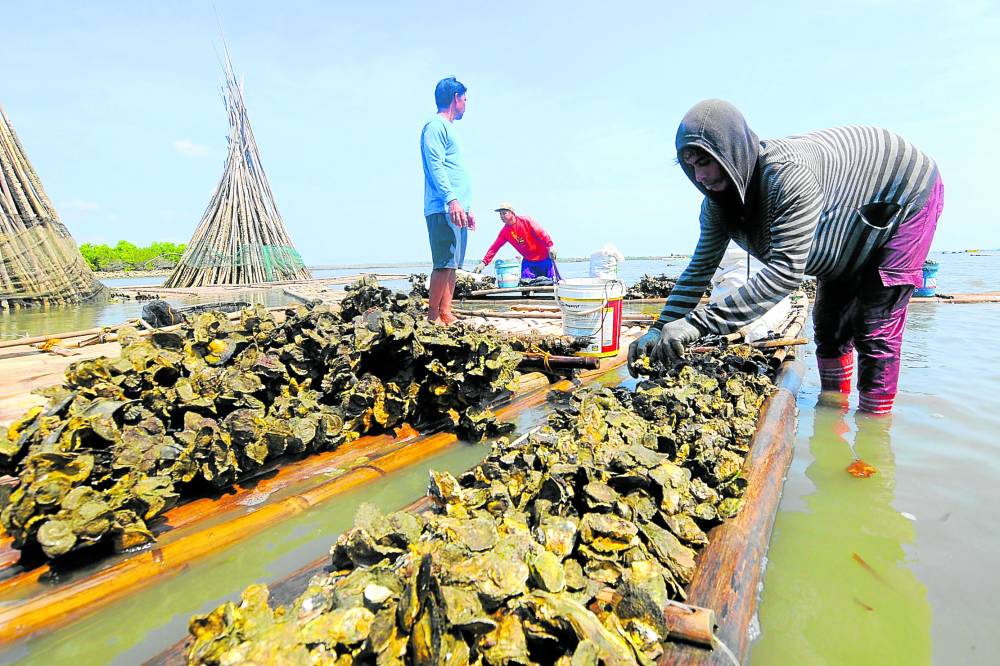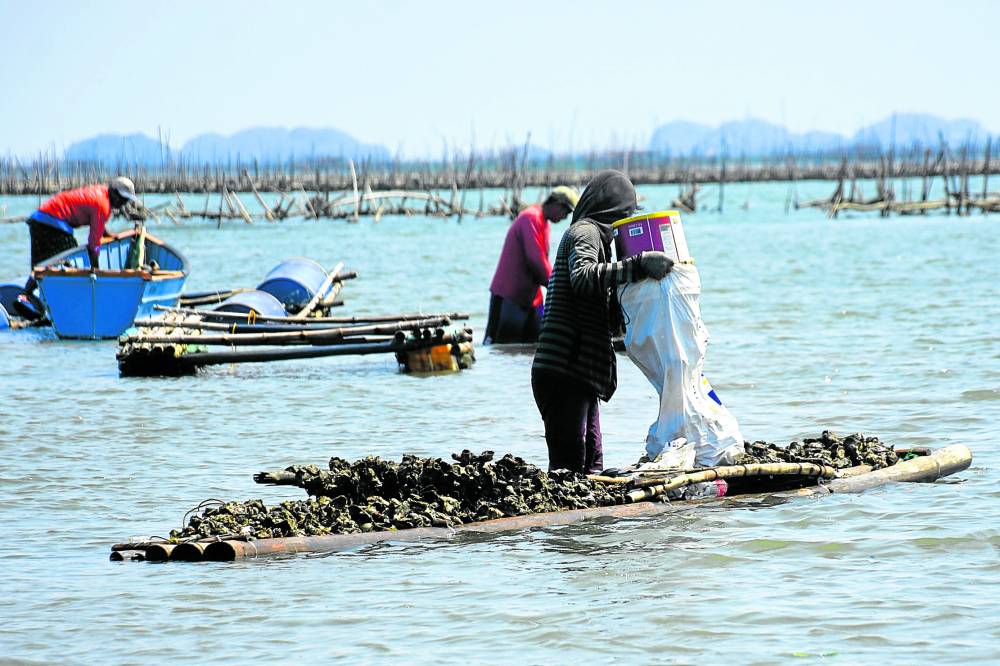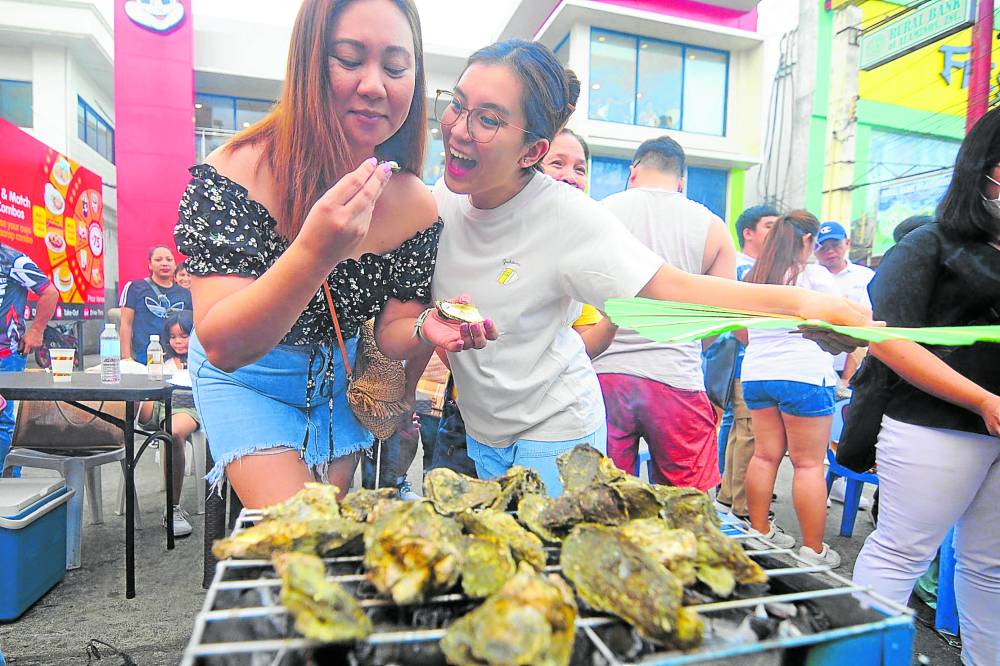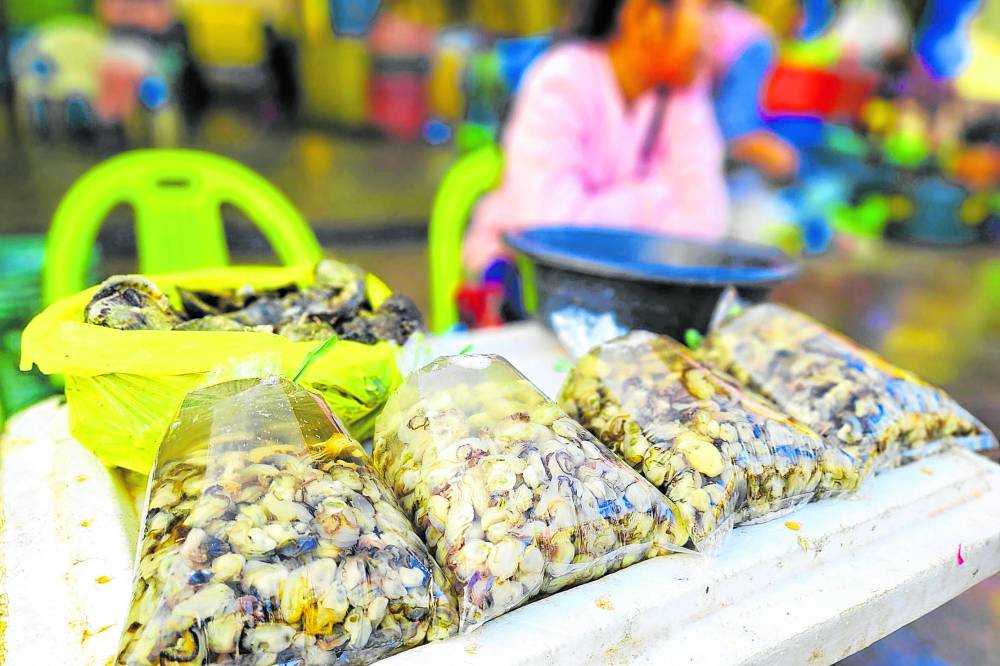Alaminos City’s ‘talaba’ industry coming slowly out of its shell

LIVELIHOOD Oysters are cultured in the coastal villages of Alaminos City in Pangasinan using either discarded rubber tires or bamboo stakes. The thriving industry is giving local fishermen an additional source of income. PHOTOS BY WILLIE O. LOMIBAO
ALAMINOS CITY, PANGASINAN, Philippines — There is nothing fancy about “talaba” (oysters) cultivated in this city as you can’t find any pearl inside their shells.
But what’s special to these bivalves is that they give local fishermen an additional source of income.
Four coastal villages in this city in western Pangasinan are engaged in oyster production, and Alaminos is quickly making a name for itself as a producer of the tasty seafood.
The local government, for the past eight years, has been staging the Talaba Ihaw-Ihaw Festival every March as part of the annual Hundred Islands Festival.
Last month, an area of the city’s central business district was cordoned off, and 185 grills were set up to cook newly harvested oysters from local sea farms.
Article continues after this advertisementREAD: Festivals return to Pangasinan after 2-year break
Article continues after this advertisementPangasinan Rep. Arthur Celeste and his son, Alaminos Mayor Arth Bryan Celeste, opened the activity by lighting the grills.
When the charcoal started to glow a fiery red, the residents simultaneously put the oysters on top of the grills. In just minutes, residents and guests enjoyed their freshly grilled oyster meat, with many slurping directly from the shell or dipping it first in vinegar for that extra kick.

SEA FRESH Fishermen belonging to Samahang Mangingisda at Magsasaka ng Baleyadaan in Alaminos harvest oysters from a farm in the village of Baleyadaan in time for the Talaba Ihaw-Ihaw, one of the events lined up for the Hundred Islands Festival held last month.
During the festival’s Agri-Trade and Tourism Fair, the city government staged the “talaba” cook fest challenge to show the versatility of oyster meat as protein substitute.
A group of residents showed that oysters could take the place of chicken or pork in many common Filipino dishes. They came up with dishes like “Bicol talaba express” and “tinolang talaba.”
READ: Humble ‘talong’ gets high-end treatment in Pangasinan cook fest
Then there was the “sweet and sour talaba with cucumber,” “lumpiang talaba,” “empanadang talaba,” “asadong talaba siopao,” “ginisa sa kamatis na talaba” and “inampalayaang talaba.”
The well-loved oyster recipes like “kilawen” and deep fried oysters were also presented differently, depending on the souring ingredients, herbs and spices that the amateur cooks used.
All the oysters used in the Ihaw-Ihaw Festival and cooking challenge were sourced from the city’s oyster farms.
Local production
According to aquaculturist Mikhaela Tamayo, a total of 1.5 hectares in the coastal villages of Pangapisan, Bahley Daan, Mona and Cayucay are devoted to oyster farming.
In 2023, 760 metric tons of oysters were harvested by some 70 fishermen engaged in its production, which is mostly for local consumption and sold to nearby towns and cities.
Mayor Celeste said the oysters sold by the roadsides in Dagupan City actually came from Alaminos.
While Alaminos has enough supply for tourists and guests who will visit the Hundred Islands National Park this summer, the production volume is not yet enough to enable farmers to cater to big industries that produce oyster-based products, Celeste said.
The city produces two oyster species, “talabang tsinelas” (Crassostrea iredalei) and “talabang kukong kabayo” (Crossostrea malabonensis), named as such because of their shapes, Tamayo said.
A sack of big (classified as “good size”) “talaba” is sold at P1,200, while smaller ones are sold for a farm gate price of P400. A floating raft can produce up to 30 sacks of oysters which supplements the fishermen’s income from fishing.

DELICACY Visitors get to taste grilled oysters and other dishes using this delicacy during the recent festival.
The Bureau of Fisheries and Aquatic Resources (BFAR) has been helping the city in its effort to develop its oyster industry.
In 2016, the agency assisted an association of farmers and fishermen in Baleyadaan by providing them with materials for the construction of 30 floating rafts. The recipients, on the other hand, contributed labor or built the rafts themselves.
The 25-square-meter rafts on which ropes are hung, are placed about a kilometer away from the shore, where seeds from the wild cling to the ropes until they mature after about eight months. Spawning is during the rainy season, or in October and November.
Last year, the BFAR-National Fisheries Development Center awarded 20 floating rafts to the city’s fishermen, a part of the agency’s strengthening oyster production under bamboo rafts.
The Department of Labor and Employment also gave eight floating rafts to the local fisherfolk association.
But private individuals also own oyster farms, said aquaculture technician Alejandro Baybon, with some still using the bamboo stake method, or arranging bamboo poles at a one-meter interval, on which oysters attach and grow.
After 10 years of holding the Talaba Ihaw-Ihaw Festival, the city is fast making a niche in the country’s oyster industry, but still needs all support it can get to make oyster culture a major income earner for its residents.
